6th GRADERS GET CRASH COURSE ON THE MISSOURI AT RIVER APPRECIATION DAY
By: Laurie Fritsch, Field Editor
USDA Natural Resources Conservation Service
Nearly 150 area 6th Graders from Vermillion, Irene-Wakonda and Centerville gathered to celebrate the 7th Annual River Appreciation Day at Clay County Park, Vermillion, SD, on Tuesday, Sept. 10, 2013. To kick off the morning segment, Bruce Gray and Cindy Gelm, the ‘Good People,’ welcomed students as the duo strummed their guitars and sang river songs to create a festive mood.
To get their wheels turning, Jerry Wilson, a local naturalist and author, greeted the kids, and asked, “What’s special about the Missouri River?” One student yelled, “Its beauty!” Another chimed in, “It’s natural.”
Then he asked, “How many of you visited a national park this summer?” A few raised their hands. Wilson asked, “Which ones?”
One student said, “Yellowstone.”
Another hollered, “The Grand Canyon!”
“Did you know you’re at a national park right now?”
His question stumped a few. But he’s right. When Lewis and Clark explored the American West, their route took them from St. Louis, MO, north to Bismark, ND, and on to the West Coast. The two explorers set up camp near Vermillion in August of 1804 and found it very similar to what it’s like today.
The Missouri National Recreational River (MNRR) was established by Congress under the Wild and Scenic Rivers Act to protect the natural, cultural and recreational resources of the two remaining free-flowing segments of the Missouri River in as natural a state as possible. One segment is the 59-mile stretch below Gavins Point Dam, and the other is the 39-mile stretch below Ft. Randall Dam. Another fascinating tidbit that Wilson shared with these youngsters is that Missouri is the longest river in America.
Grace Freeman, Cindy Kirkeby and Nancy Carlsen, organized this yearly event. They desire for each student to take an active part in this unique hands-on learning experience to discover the sights, sounds and smells at the river through art, science, history and boating.
When Wilson finished his comments, Freeman directed students from Centerville and a portion of the Vermillion students attending the morning session, to University of South Dakota (USD) students volunteering as Trail Guides. As each group of nine to 11 students gathered they took off with their respective Trail Guides to explore the seven campsites on the trail. Students received 14-minute lessons at each stop. Presenters crammed as much information in as they possibly could. But when everyone heard the first whistle blow 13 minutes into the lesson, they had one minute to finish up.
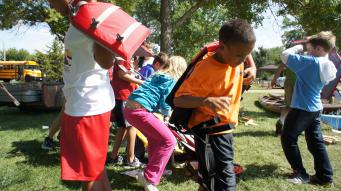 First up, Karla Zeutenhorst and Jeffrey Cook, Park Rangers for the Omaha District of the Army Corp of Engineers, talked about how to be safe when swimming and boating. Zeutenhorst said, “As many as 8,000 people drown in lakes and rivers every year.” In too many cases, according to Zeutenhorst, the person who died had their life jacket in the boat, but didn’t bother to put it on. In some cases, the victim put their life jacket on but didn’t buckle it before tragedy struck.
First up, Karla Zeutenhorst and Jeffrey Cook, Park Rangers for the Omaha District of the Army Corp of Engineers, talked about how to be safe when swimming and boating. Zeutenhorst said, “As many as 8,000 people drown in lakes and rivers every year.” In too many cases, according to Zeutenhorst, the person who died had their life jacket in the boat, but didn’t bother to put it on. In some cases, the victim put their life jacket on but didn’t buckle it before tragedy struck.
Like drill sergeants, the Park Rangers ordered the kids to line up for a 60-second life-jacket relay to see how many could get their life jacket on and buckled before time was up. Zeutenhorst said, “It takes about one minute to put your life jacket on when you’re on dry ground. But more like 10 minutes if you attempt it struggling in the water.”
Cook urged each student to get a Coast-Guard approved life jacket that fits properly. “Most importantly, if you want to be safe on the water, what do you need to do?” he asked.
The kids yelled back, “Wear your life jacket and swim with a buddy!”
Troy Garrett, Vermillion’s School Psychologist, new to the event, listened to Zeutenhorst address his students about water safety. Rather amazed, he said, “I just hope that they understand the value of what she’s talking about. In just the first five minutes the information she’s shared with them is great."
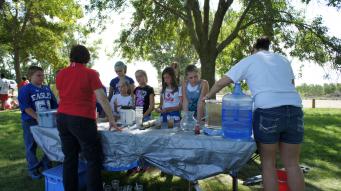 Next the kids arrived at Aquifer Camp and met Sarah Chadima, a geologist for the South Dakota Geological Survey. She said, “I’m so thirsty. I’ve just got to have a drink.” Then to their utter amazement she began to drink a beverage from a glass filled with gravel. To ease their nerves, she told them that sand and gravel act like ice cubes. She talked with them about ground water. “In Vermillion, we drink from water that flows through sand and water. The Missouri flood plain has been filled with sand and water for over 10,000 years.” Chadima explained that the City of Vermillion extracts its drinking water from the Missouri aquifer. After it’s treated at the water treatment plant, it’s safe to drink. Switching gears, then Chadima released red food coloring into an interactive water model to illustrate how pollution moves through an aquifer. She also discussed the water cycle, water quality, why it’s important to test the acidity of water, and how to clean up various kinds of spills to prohibit or reduce contamination of ground water.
Next the kids arrived at Aquifer Camp and met Sarah Chadima, a geologist for the South Dakota Geological Survey. She said, “I’m so thirsty. I’ve just got to have a drink.” Then to their utter amazement she began to drink a beverage from a glass filled with gravel. To ease their nerves, she told them that sand and gravel act like ice cubes. She talked with them about ground water. “In Vermillion, we drink from water that flows through sand and water. The Missouri flood plain has been filled with sand and water for over 10,000 years.” Chadima explained that the City of Vermillion extracts its drinking water from the Missouri aquifer. After it’s treated at the water treatment plant, it’s safe to drink. Switching gears, then Chadima released red food coloring into an interactive water model to illustrate how pollution moves through an aquifer. She also discussed the water cycle, water quality, why it’s important to test the acidity of water, and how to clean up various kinds of spills to prohibit or reduce contamination of ground water.
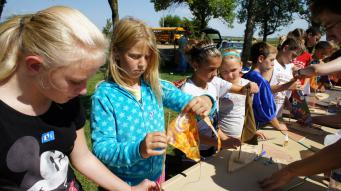 March on to Boat Camp; one of the camp favorites this year. Harry Freeman and Terry Hill, Vermillion educators, boat builders, and river experiencers, covered the differences between a kayak and a row boat, plus water safety. After this they turned it over to USD volunteer, Lukas Bernard, who gave the kids tips about how to build the fastest sailboat. Students paired off in teams of two or three and quickly assembled, decorated and named their boats to prepare for the boat race later that morning. Harry explained, “I want them to learn about non-motorized craft. It’s the best way to enjoy the river. It’s easy to navigate and a better way to observe wildlife. If you want, you can pull over to the sandbar, get out and just enjoy the river.”
March on to Boat Camp; one of the camp favorites this year. Harry Freeman and Terry Hill, Vermillion educators, boat builders, and river experiencers, covered the differences between a kayak and a row boat, plus water safety. After this they turned it over to USD volunteer, Lukas Bernard, who gave the kids tips about how to build the fastest sailboat. Students paired off in teams of two or three and quickly assembled, decorated and named their boats to prepare for the boat race later that morning. Harry explained, “I want them to learn about non-motorized craft. It’s the best way to enjoy the river. It’s easy to navigate and a better way to observe wildlife. If you want, you can pull over to the sandbar, get out and just enjoy the river.”
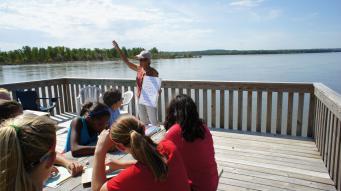 Norma Wilson, poet, educator, and member of the Vermillion Area Arts Council, taught students how to write Haiku poetry, an ancient Japanese form of poetry. She said, “You can write about the fish that swim in the Missouri, like the Paddle Fish or the Sturgeon; fish that date back thousands of years. Write about the animals you see like the great Bald Eagle. Write about a lot of different things that you see and hear at the river. Write about what you feel.” These young poets were pushed for time, but gave it their best shot. Keep in mind that a Japanese Haiku has five syllables in the first line, seven in the second line and five in the third and final line. When they finished, Wilson invited them to put their poem in the, “2013 River Day Haiku Book of Poetry.”
Norma Wilson, poet, educator, and member of the Vermillion Area Arts Council, taught students how to write Haiku poetry, an ancient Japanese form of poetry. She said, “You can write about the fish that swim in the Missouri, like the Paddle Fish or the Sturgeon; fish that date back thousands of years. Write about the animals you see like the great Bald Eagle. Write about a lot of different things that you see and hear at the river. Write about what you feel.” These young poets were pushed for time, but gave it their best shot. Keep in mind that a Japanese Haiku has five syllables in the first line, seven in the second line and five in the third and final line. When they finished, Wilson invited them to put their poem in the, “2013 River Day Haiku Book of Poetry.”
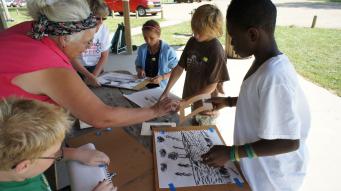 Students created amazing river landscapes at Art Camp drawing with vine charcoal, tutored by Nancy Losacker, a visual artist, educator and another member of the Vermillion Area Arts Council. “We’re going to draw a landscape of the river,” she said. “It’s so big, so wide. You can’t draw everything. So look into your viewfinder to decide what you want to draw. Get the big idea down and then go back and work on the details. Go for it! Draw what you see. Don’t try to make it up. What do you see?”
Students created amazing river landscapes at Art Camp drawing with vine charcoal, tutored by Nancy Losacker, a visual artist, educator and another member of the Vermillion Area Arts Council. “We’re going to draw a landscape of the river,” she said. “It’s so big, so wide. You can’t draw everything. So look into your viewfinder to decide what you want to draw. Get the big idea down and then go back and work on the details. Go for it! Draw what you see. Don’t try to make it up. What do you see?”
Michele Meckling, Vermillion, a volunteer at Art Camp, added, “Drawing is fun! It’s something you can enjoy by yourself. You don’t need a team to do it.”
As the group finished their landscapes, Losacker said, “It’s wonderful to draw. You don’t have to have a lot of time. Start drawing. It’s something you can do anytime, anywhere. And you’re so lucky to get to do it outside today.”
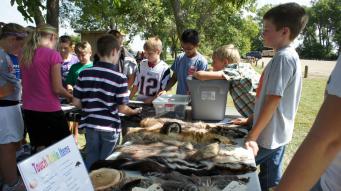 To learn more about animals that live near the river students headed for Animal Camp located by the tipi. They completed their lesson with Clay and Union County Natural Resources Conservation Service (NRCS) employees Aaron Sisson, Wetland Specialist, and Ryan Frickel, who works as a Soil Conservationist.
To learn more about animals that live near the river students headed for Animal Camp located by the tipi. They completed their lesson with Clay and Union County Natural Resources Conservation Service (NRCS) employees Aaron Sisson, Wetland Specialist, and Ryan Frickel, who works as a Soil Conservationist.
With no time to waste, Sisson asked,” Do you guys know what natural resources are?” A few students answered things like trees, air and water. These are correct answers, but to be certain everyone understood his question, Sisson defined ‘natural resources’ as those things that nature provides us in which we benefit from, like air to breathe.
Next the kids took a pop quiz to see if they could match pictures of seven animals to the correct skull displayed on the table; treasures which Sisson has discovered on the job. His collection included skulls from a Raccoon, Prairie Dog, White-tailed Deer, Coyote, Skunk, Mule Deer and Cottontail Rabbit.
Sisson and Frickel discussed differences between the White-tailed and Mule Deer, plus plant eaters, meat eaters, and critters that eat both.
Then Frickel invited students into the tipi to check out the animal pelts provided by the South Dakota Game, Fish and Parks Outdoor Campus, including: Bobcat, Fox, Coyote, Rabbit, Bear, Mink and Mountain Lion.
So what’s the ‘take-home’ value from Animal Camp? Sission explained, “We’d like them to take an interest in wildlife.”
Frickel agreed and added. “I want to encourage them to get outdoors and appreciate our natural resources.”
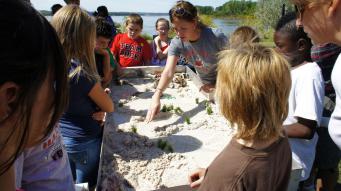 Hanging out at Stream Camp was a blast. The kids watched every move of Melissa Campbell, the leader at Stream Camp and research associate at the Missouri River Institute, as she played with plastic sand to mimic the meandering nature of the Missouri River. She said, “It’s important for you to understand how the river works and what you might learn if you study the Missouri River for years. Minor adjustments in the river can really change how the river moves.”
Hanging out at Stream Camp was a blast. The kids watched every move of Melissa Campbell, the leader at Stream Camp and research associate at the Missouri River Institute, as she played with plastic sand to mimic the meandering nature of the Missouri River. She said, “It’s important for you to understand how the river works and what you might learn if you study the Missouri River for years. Minor adjustments in the river can really change how the river moves.”
She shared what a powerful force the river is, reciting details about the Vermillion flood of 1881. Campbell explained, “It washed downtown Vermillion away in a half hour. Huge chunks of ice floated down the Missouri and bulldozed down houses and businesses in its path.”
John Erickson, Vermillion, a stream table volunteer and amateur naturalist, added, “The river’s always changing. It’s like the ‘circulatory system’ of this planet.
“There’s beauty inherent in our world and often an indicator that there’s something worth paying attention to. There’s a lot of creativity in science and art in our natural world. For example, there are reasons why you find patterns in the silt. If you see a pattern in the silt, stop and ask yourself why it’s there.”
To wrap up the morning’s adventure, campers gathered to hear the Oyate Drum with Wayne Evans, professor emeritus and elder. Then kids headed for the river’s edge to watch their boats race down the Missouri River. Vermillion’s boat, ‘Lightening’ captured the winner’s spot.
At that point, Freeman and the presenters and volunteers bid farewell to the kids and teachers. Though reluctant to return to the classroom, they climbed back on their buses and headed back to school.
Organizers kept everyone on schedule. Not more than 40 minutes passed and 60 more students from Vermillion and Irene-Wakonda arrived to continue the celebration at the river. Freeman welcomed them gave them a rundown of the afternoon schedule.
Before heading to camp they enjoyed the Oyate Drum and participated in a river dance. Without a minute to lose, Trail Guides hailed their assigned campers and hurried off to their first river lesson. When everyone finished their rounds to each campsite, they assembled for Jerry Wilson’s river commentary.
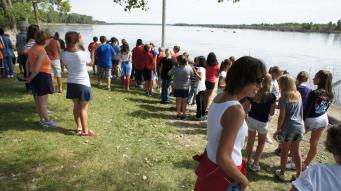 Freeman announced it was time for the boat race and the kids beat a path to the Missouri’s edge. Students clapped and cheered as they watched their boats race to the finish line downstream. The ‘Tornadic Eagle’ built by Team Irene-Wakonda including Tate Van Beek, Marcus Brewer and Isabelle Libby, was announced the winner.
Freeman announced it was time for the boat race and the kids beat a path to the Missouri’s edge. Students clapped and cheered as they watched their boats race to the finish line downstream. The ‘Tornadic Eagle’ built by Team Irene-Wakonda including Tate Van Beek, Marcus Brewer and Isabelle Libby, was announced the winner.
Freeman, and the crew on hand to help with the day’s activities, thanked the kids for coming. Although Irene-Wakonda students have attended this event in the past, Jessica Lucas the 6th Grade Teacher for Irene-Wakonda School District, attended River Appreciation Day for her first time.
Lucas said, “It was a great day! My students loved building their sailboats and watching them race. That was their favorite part.”
The thing that impressed Lucas the most was that students were in small groups so their questions could be answered. She said, “They were able to get hands-on learning which is better than learning from a textbook.”
Lee Pederson, the Middle School Science and Social Studies Teacher at Centerville Public School, also attended for the first time. Most notable to him was that USD allowed students to participate as well. He commented, “The USD students helped the groups get from one camp to another and kept the students focused. This really aided in the learning process. I was also impressed that the presenters were so well organized and covered so much material in 14 minutes.
Pederson explained that the only thing he’d change is to make the morning and afternoon sessions longer so the students have more time to enjoy Clay County Park. He said, “On the way home the students couldn’t stop talking about the boat race. They had a great time and there was something for everyone.”
Jerry Wilson thanked the kids for coming, and said, “It’s been a nice day to learn about the river. The Missouri’s a great river and this is a wonderful national park. Save it. Love it and enjoy it. Preserve, respect and restore our natural resources for future generations.”
An outing like this would be impossible to offer without help of volunteers, community supporters and funding from a variety of sources. Grants were received from: Izaak Walton League of America, Living River Group of the Sierra Club, SD Water Festival, SD Discovery Center, University of South Dakota, Vermillion Area Arts Council and Vermillion Basin Water Development District.
Donors of in-kind contributions came from: American Rivers, Clay County Park Association, Clay Union Electric Co-op, National Park Service, South Dakota Game, Fish and Parks Outdoor Campus in Sioux Falls, Clay and Union County Natural Resources Conservation Service, U.S. Army Corps of Engineers and Vermillion Area Farmers Market.
Community volunteers who helped include: Sandy Pederson, Michele Mechling, John Erikson, Todd Brevik, Linda Lane and Maggie Pettersen.
USD students who volunteered included: Katie Manson, Savanna Williams, Xue Jiang, Danelle Tramp, Danielle Anderson, Kaiti Porter, Lukas Bernard, Tyler Kittle, Charli Cochran, Holly Pedersen, Chris Zimmer and Ashley V. Johnson.